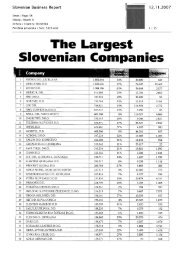The Group KD Group and KD Group dd
The Group KD Group and KD Group dd
The Group KD Group and KD Group dd
Create successful ePaper yourself
Turn your PDF publications into a flip-book with our unique Google optimized e-Paper software.
<strong>The</strong> <strong>KD</strong> <strong>Group</strong> Annual Report 2009<br />
ANALYSIS OF OPERATIONS<br />
Capital markets in 2009<br />
<strong>The</strong> US <strong>and</strong> Europe in 2009<br />
In the latter months of 2008, the financial crisis of 2007, with its epicentre in the USA who account for almost one quarter of<br />
the world’s GBD <strong>and</strong> over 16 percent of global dem<strong>and</strong>, shifted from financial markets to the real market, spreading to the<br />
whole world. In the first quarter of 2009 there was no single safe investment as all sectors were in the red. In the beginning of<br />
March, the US S&P 500 index fell through the 700 barrier <strong>and</strong> continued its fall, reaching its lowest point in the past thirteen<br />
years on 9 March with 666 points. <strong>The</strong>re was much talk about the possible repeat of the depression from the 1930s, about<br />
the volatility of the financial system, potential nationalisation of some of the largest US banks, <strong>and</strong> similar scenarios. When<br />
the probability of such scenarios occurring reduced <strong>and</strong> several sectors succeeded to regain the position before the failure of<br />
the US investment bank Lehman Brothers, the conditions were right for the beginning of the strong growth of global stock<br />
markets. <strong>The</strong> winner of the first half of the year was the technology sector which in the first six months of 2009 gained 24.08<br />
percent, followed by the energy <strong>and</strong> raw materials sector with 12.28 percent growth <strong>and</strong> the sector of durable consumer<br />
goods which in that same period gained 7.52 percent, whereas the financial <strong>and</strong> industrial sector remained in negative<br />
figures in the first half of 2009 recording a 4.76 percent <strong>and</strong> 7.68 percent decline respectively. In the second half of 2009, the<br />
market needed proof that the economy had reached the bottom <strong>and</strong> was eagerly awaiting the first information of the actual<br />
outset of economical revival in the developed world. <strong>The</strong> next condition for higher exchange quotations was the publication of<br />
profits achieved in the second quarter of 2009 which, in the case of US S&P 500 index, surpassed all analysts’ expectations<br />
in over 70 percent of announced results. In a<strong>dd</strong>ition to these, the zero interest rates <strong>and</strong> support in the increased liquidity of<br />
central banks which a<strong>dd</strong>itionally contributed to high gains on stock markets, should not be overlooked. After the credit crunch<br />
in the second half of 2008 <strong>and</strong> the first few months of 2009, central banks were forced to, with increased liquidity, support the<br />
financial sector, make available credit lines <strong>and</strong> support the remaining economy in the developed world. <strong>The</strong> US S&P 500<br />
index recorded a nearly 26 percent growth at the end of 2009 <strong>and</strong> by the beginning of March, it increased by a total of 68<br />
percent compared to its lowest point. Last year’s growth of the S&P 500 index is the highest since 2003. Revival of the<br />
labour market <strong>and</strong> accessibility to <strong>and</strong> availability of new loans will be of key importance in 2010. <strong>The</strong> question of how stable<br />
is the final consumption which is, as has been demonstrated several times, to a large extent dependent on the repayment of<br />
debt of US consumers, still remains. In the past 20 years, consumers financed increased consumption with ever increasing<br />
indebtedness, a process which is, at least for the time being, locked. Increased consumption on account of higher stock<br />
market prices cannot be expected since real estate prices continue to be under pressure <strong>and</strong> nearly two thirds of an average<br />
American family’s assets are tied in this particular segment. <strong>The</strong> rate of savings is currently stable at around 4 <strong>and</strong> 5 percent<br />
<strong>and</strong> since production capacity utilisation remains at historically low levels, no wage <strong>and</strong> salary increases can be expected at<br />
least in the short-term. <strong>The</strong> main risks that could in 2010 surprise investors include the following:<br />
• Private sector’s inability to compensate for reduced government subsidies.<br />
• Analysts’ expectations during the year may become too optimistic.<br />
• Bank balances are worse than is currently reported.<br />
• Any difficulties in China.<br />
• Problems with government debt (Greece, Spain, Portugal, Irel<strong>and</strong>, Italy <strong>and</strong> other)<br />
• US dollar growth <strong>and</strong> break in the “carry trade” process.<br />
Other global markets<br />
In the developing economies, the beginning of 2009 was marked primarily by a number of crises aimed at stimulating the<br />
national economies. Central banks continued to reduce the base interest rates, while the governments were providing<br />
cashrescue plan, planning increased budget expenditures <strong>and</strong> through changed tax policies, waived future budgetary<br />
revenue. In November the government of the largest Asian economy, China, adopted aid package of nearly US$ 600 billion,<br />
which accounts for nearly 15 percent of its gross domestic product, with a view to primarily increase expenditure for<br />
infrastructure construction <strong>and</strong> modernisation, reduce taxes <strong>and</strong> provide welfare aid to the poorest. <strong>The</strong> global crisis was a<br />
strong signal to China that it will have to change its GDP structure, increase the share of domestic consumption <strong>and</strong> reduce<br />
its dependency on imports. In spite of a widespread scepticism that prevailed at the beginning of 2009, it is clear today that<br />
in 2009, Chinese economy with its 8.7 percent growth in GDP, was the main driving force behind the global economic revival.<br />
Despite low exports, by fiscal <strong>and</strong> monetary measures China succeeded in making domestic dem<strong>and</strong> the principal driver<br />
behind economic growth. With almost no exceptions, in 2009 central banks in developing economies reduced interest rates<br />
<strong>and</strong> some also reduced obligatory reserves which commercial banks have to ensure.<br />
31







